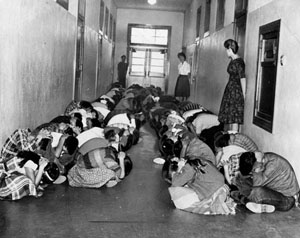School Lockdowns, Lockdown Normalcy: Student safety in schools is not a new concern; however, due to increasingly violent and seemingly greater prevalence of serious incidents, school safety is on just about everyone’s radar, especially those of us with young children. We are now in an age of “lockdown normalcy”. Safety drills in school are commonplace and date back many years. Who doesn’t remember having fire drills in school, ensuring you walk out of the building in an orderly fashion (covering your ears, of course, to muffle the wailing alarm) to a pre-determined meeting place and wait for the “go ahead” to return to class? Most people don’t think twice about having fire drills, because of course, we want children and teachers to be prepared in the event of a fire. There is a sense of normalcy with fire drills, in that they are expected, routine and part of our American school culture.
In Southeastern CT as well as other parts of the country in the 1960′s, right at the height of the Cold War, students had “duck and cover” drills, during which they were instructed to either scramble underneath desks and curl up in a ball or kneel near a wall with their heads down (there were many variations of this drill). Schools had to be prepared in case of nuclear fallout, or in some cases, potential attacks from other countries. (To view a fallout information guide, check out the National Archives website:
http://www.archives.gov/education/lessons/fallout-docs/). Again, these drills were part of the school’s routine, and there was a sense of normalcy in their practice. Students began to expect these drills just the same as they did fire drills. In both of these safety scenarios, schools were doing what they had to do to ensure the safety of students within its walls, and today’s lockdown drills are designed to do the same. Scary as it is to think of something terrible happening to children at a school, lockdown drills are a part of American schooling in this day and age, and in many cases, have already achieved the same sense of normalcy as fire drills, particularly among elementary school aged children.
What is disconcerting to adults about lockdown drills is their normalcy: we shouldn’t HAVE to practice them. We shouldn’t have to worry about an armed gunman entering a school and shooting people. We shouldn’t have to teach our kids from an early age what to do in case someone comes at them with a firearm while in the classroom. We shouldn’t but WE DO, and schools are smart to be proactive in practicing lockdown drills as well as having firm safety procedures and protocol in place. As adults, we know it’s not normal to practice hiding from a gunman in a place where we are supposed to feel safe; however, for today’s American student, this practice must become part of the normalcy of safety routines. It’s just a sad fact that we all have to face and deal with, because quite honestly, it’s a bigger deal to us than it is to the children who participate in the drills. After some time, they will view these drills as a normal part of the routine, just as we did with fire drills, and that is okay. We want our kids to be prepared in case of any emergency, and lockdown drills, whether practicing for an armed assailant or severe weather, are now a necessary and essential part of a child’s school life.
Now is the time of year when many schools begin practicing safety drills, including but not limited to, lockdowns. Schools can provide you with resources on how to talk these over with your child, should he or she come home with any questions or concerns. The Internet is filled with resources as well, ranging from highly acclaimed and reputable to downright ridiculous and scary. The best thing you can do as parents is ask your school for what they recommend you read.
As a teacher, what I can tell you is this: we will do anything to protect your child in case of an emergency, not because it is a job requirement but because it is part of the innate sense of caring that teachers possess. I guarantee you after hearing about school shootings, the majority of teachers asked themselves “what would I have done?”. It is hard NOT to imagine yourself in a similar scenario and run through your head what you would do if faced with an armed assailant. Everyone I spoke to about this would protect their students at any cost, even if it meant their own personal safety and not think twice about it. If a teacher says he or she would not take a bullet for a child, then he or she is in the wrong profession.
It is impossible to guarantee complete safety anywhere at all times, even within your own home. But what improves safety is having procedures in place and practicing them, difficult as they may be for us to stomach. If we as parents treat lockdown drills as normal, then our kids will view them as such and thus help such procedures become a natural part of our American school culture.
Columbus Day Next Post:
Boarding Schools: To Board Or Not To Board







